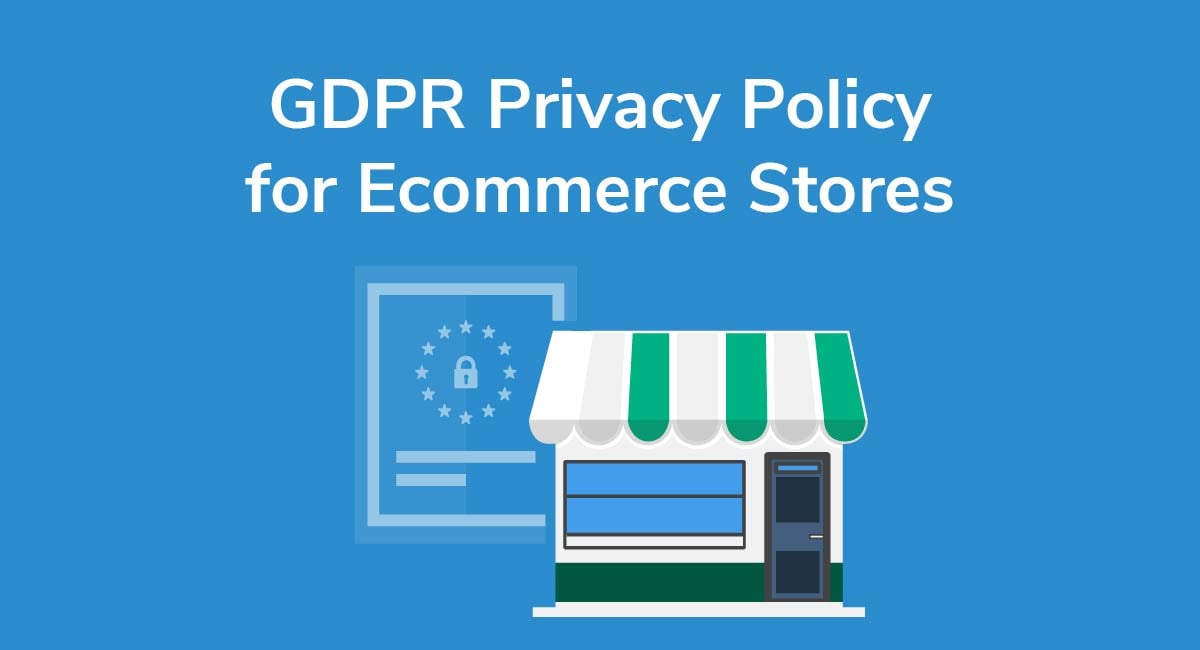Return and Refund Laws in the EU
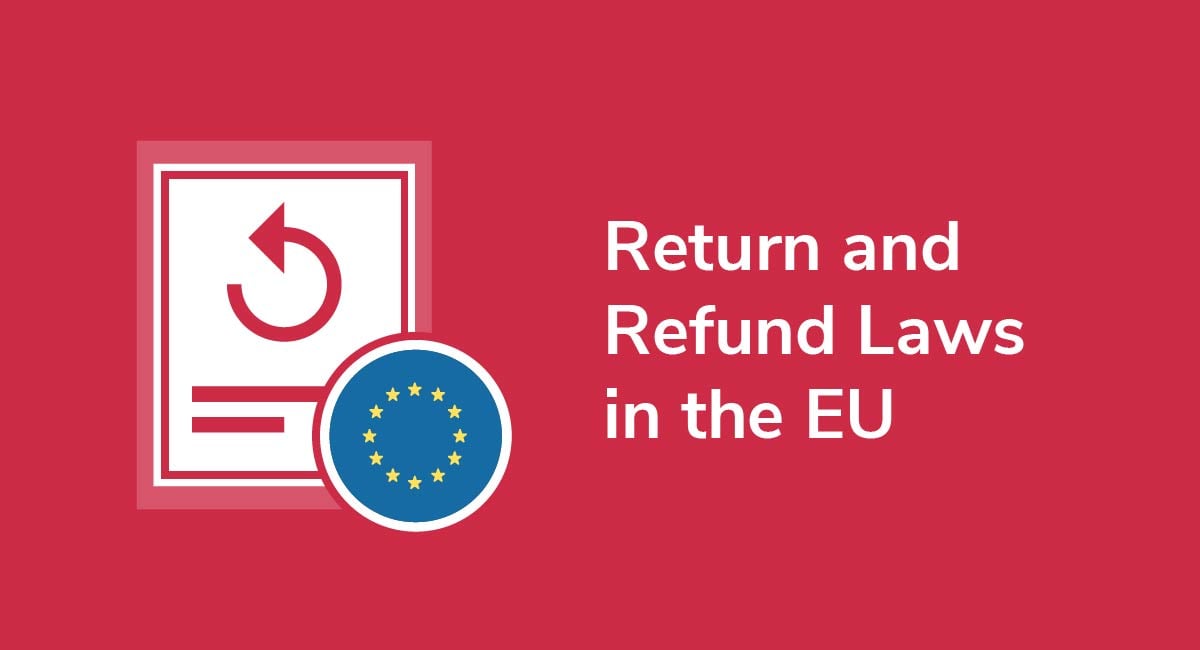
Merchants that sell goods and services to residents of the European Union (EU) and the European Economic Area (EEA) are subject to Return and Refund laws aimed at protecting consumers.
Compliance can be tricky because many member nations also pass their own Return and Refund laws, but if you sell anything in the EU or EEA, you're legally required to have a Return and Refund Policy.
In this article, we'll cover relevant EU Return and Refund laws and what to include in your Return and Refund Policy.
Get compliant today with PrivacyPolicies.com
Select one of our generators to create the required legal agreements for your business:
- Our Privacy Policy Generator can help you generate a customized Privacy Policy in around three minutes, for free.
- Our Terms & Conditions Generator can help you generate a customized Terms & Conditions agreement in around three minutes, for free.
- Our EULA Generator can create a customized End-User License Agreement for your mobile or desktop app.
- Our Cookies Policy Generator can create a customized Cookies Policy to help your compliance with ePrivacy Directive and GDPR.
- Our Disclaimer Generator can create a disclaimer or disclosure for your website.
- Our Return & Refund Policy Generator can help your ecommerce store by creating a returns or refunds policy.
Integrate a free Cookies Notice and Cookie Consent banner to comply with the EU ePrivacy Directive and the new GDPR law regarding cookies.
- 1. What is a Return and Refund Policy?
- 2. EU Return and Refund Laws
- 2.1. Right of Withdrawal
- 2.2. Conformity Guarantee for Defective Goods
- 3. What to Include in an EU Return and Refund Policy
- 3.1. Right of Withdrawal
- 3.2. What Customers Must Do to Initiate a Return
- 3.3. How You'll Process Returns
- 3.4. How Defective Products Will be Handled
- 3.5. What Exceptions Apply
- 4. EU Return and Refund Policy Placement
- 5. Summary
What is a Return and Refund Policy?
Return and Refund Policies are created by sellers (traders or merchants) to let customers know how they can initiate a return, exchange, or request a refund.
Return and Refund Policies should also do the following:
- Define terms used in the policy (for example, what constitutes a defective product)
- Let customers know what steps they must take to get their issues resolved
- List what documentation they must provide
- Let customers know what you'll do after the process has been initiated
- Establish a timeframe for resolution
- List exclusions and restrictions
- Establish legal jurisdiction
EU Return and Refund Laws

When the EU Consumer Rights Directive was passed in 2014, it presented new compliance challenges for businesses in many countries.
As a result, some merchants found it necessary to amend, upgrade, or totally revamp their Return and Refund Policies to stay in compliance with EU regulations and national laws.
The Directive's new provisions included the following protections:
- Customers are entitled to a full refund when they cancel a purchase within 14 days (it was previously seven days)
- If a merchant fails to inform customers of this right, the period of withdrawal automatically extends to one year
- Merchants must clearly display the total cost of a product or service by eliminating hidden fees and surcharges (particularly on internet transactions)
- Merchants are forbidden to pre-check boxes to get passive agreement from customers
- Merchants can no longer charge additional fees for credit card transactions
Merchants can add their own terms for returns that fall outside these parameters as long as they don't run afoul of EU law.
Right of Withdrawal
Consumers in the EU have a 14-day cooling-off period to cancel their order and return their purchase for any reason or no reason at all, even when the product or service works as advertised.
As of January 1, 2022, this protection also covers digital services and content.
The 14-day clock starts when customers receive their goods, and they have another 14 days to return the product after informing the seller that they intend to do so.
Merchants must also refund shipping costs on returned goods, but the 14-day window only applies to purchases made online, by telephone or mail, or from an outside salesperson. It doesn't apply to in-store purchases because these customers have the luxury of seeing and handling items first.
The following items are generally exempt from the 14-day cooling-off period:
- Personalized goods like embroidered shirts and hats
- Perishable goods like food and fresh flowers
- Clothing like swimsuits and undergarments
- Jewelry like earrings
- Date-specific items like concert tickets and hotel bookings
Sellers can't always insist that products are returned in the original packaging, but customers are required to keep items in good condition until they're returned.
Conformity Guarantee for Defective Goods
Consumers in the EU and EEA are also protected by a two-year Conformity Guarantee that allows them to return products purchased online, in a store, or by phone or mail.
Products and services are non-conforming when:
- They have a manufacturing defect or defects
- They don't look or perform as promised
- They can't be used for the purpose for which they were intended
- Their functionality doesn't match, or they don't have qualities listed in advertising or product descriptions
- The buyer didn't receive all the accessories
- The instructions are incomplete or impossible to understand
This guarantee is a minimum requirement, and sellers must give consumers a discount or full refund when items can't be repaired or replaced.
However, these rules may not apply to damage caused by normal "wear and tear," abuse, and misuse.
It's worth noting that the EU-mandated Conformity Guarantee is separate from a commercial warranty, the latter of which is generally optional.
What to Include in an EU Return and Refund Policy

Including the following sections and information in your Return and Refund Policy will help you comply with EU return and refund laws.
Right of Withdrawal
In this section, you should explain when and how customers can return goods, what time limits apply, and what items are subject to special restrictions or cannot be returned for any reason.
Here's how London-based apparel retailer Marks & Spencer addresses returns, refunds, and exchanges:
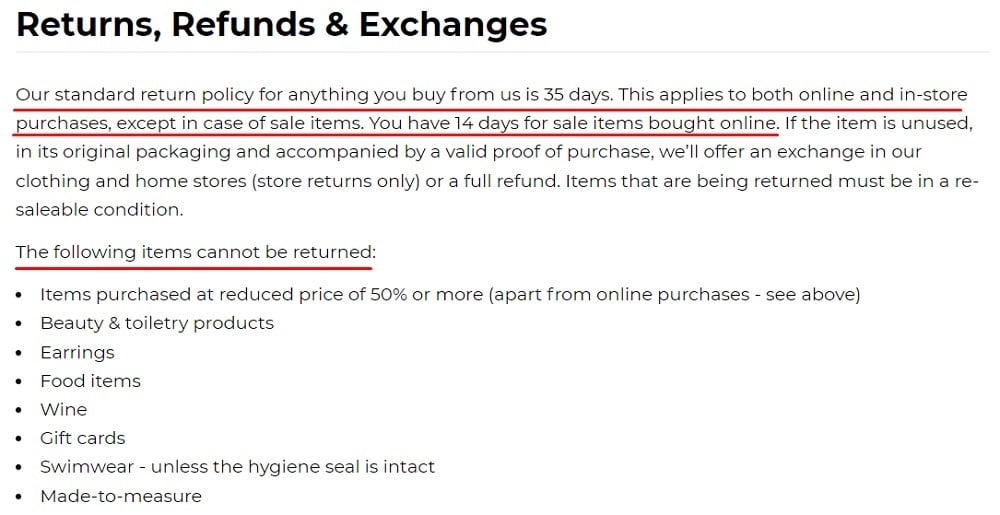
Pre-owned watch seller Watch Collectors lets customers know that the 14-day Right of Withdrawal doesn't apply to in-store purchases and that they're responsible for shipping costs unless the watch they bought was faulty:
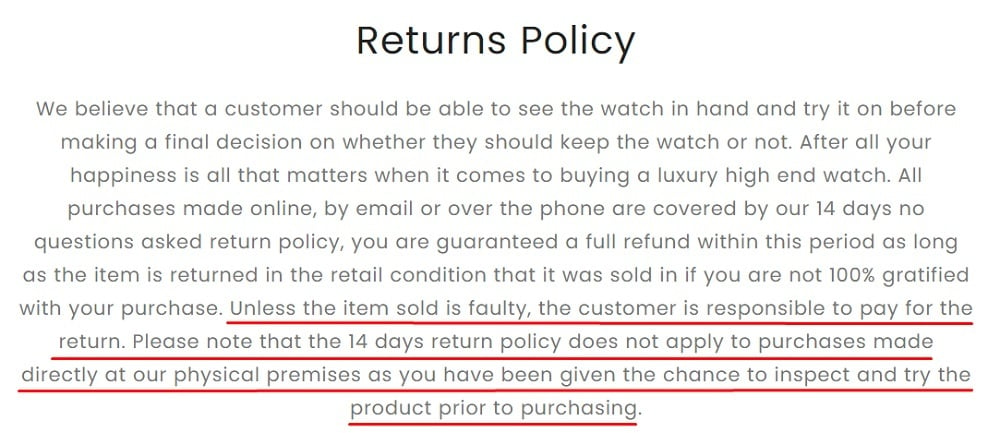
What Customers Must Do to Initiate a Return
It's important to lay out a clear path for customers who are experiencing product or service issues and wish to start a return.
When crafting your Return and Refund Policy, consider including the following information:
- How customers can initiate a return
- Where the goods must be sent
- Whether a particular carrier must be used
- Any documentation or reference numbers that must be included
FILA Germany addresses Returns as follows:

How You'll Process Returns
In addition to letting customers know how to initiate returns and request refunds, you'll want to lay out how you'll try to resolve their issues. Be specific about timeframes and steps you may take.
In its Return and Exchange Policy, Swatch states that, at its discretion, it will send a replacement or issue a refund within 72 hours when a customer has received an incorrect or damaged product:
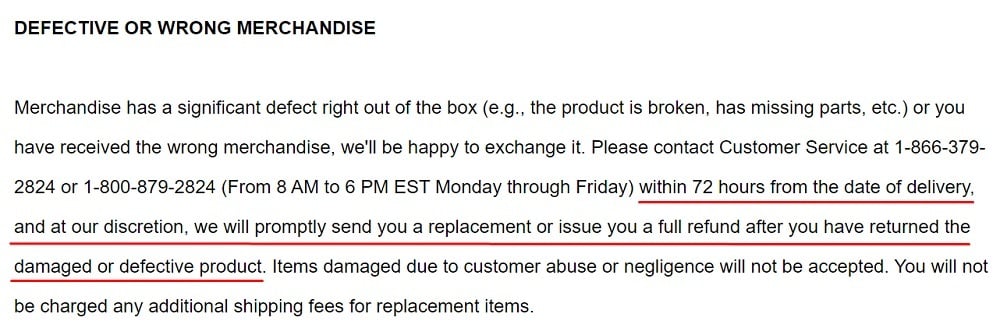
Here's how Tesco notes how many different payment methods will be refunded:

How Defective Products Will be Handled
Letting customers know that you'll repair or replace defective products in accordance with EU law can give them peace of mind while helping to build brand loyalty.
Here's how Haier Great Britain addresses returns and refunds for damaged, defective and incorrect products:

What Exceptions Apply
Make it known if there are any exceptions to what you accept returns or refund requests on. For example, if you don't allow any refunds for sale items, make this clear. Or, if different items have different return processes.
Because Tesco sells both perishable and non-perishable items, it addresses refunds and exchanges for each category separately:

Now we will look at where you should place your EU Privacy Policy for maximum effectiveness and compliance.
EU Return and Refund Policy Placement

You can place your Return and Refund Policy as a section within your Terms and Conditions agreement or as a standalone document linked to your website, such as within your site's footer.
Some merchants place their Return and Refund Policies in both locations to ensure maximum visibility, and many format their policies as FAQs to help customers get relevant information as quickly and conveniently as possible.
IKEA Spain places its Return and Refund Policy link in its website footer under the help section:
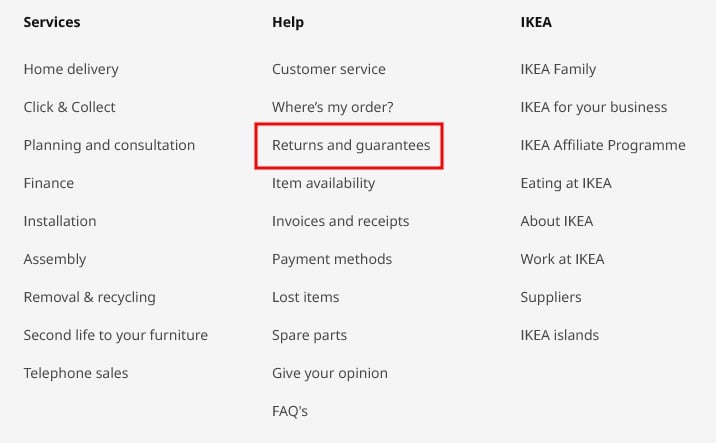
Nike UK includes information about returns and refunds, as well as a link to where more information about returns and refunds can be found, all within within its Terms of Sale:

Summary
If you sell products or services to residents of the EU or EEA, you're legally required to have a Return and Refund Policy that addresses the following:
- Right of Withdrawal: Consumers have a 14-day cooling-off period to cancel their order and return their purchase for any reason
- Conformity Guarantee for Defective Goods: Consumers have two years to return defective products that they purchased online, in a store, or by phone or mail
Your EU Return and Refund Policy should also do the following:
- Define the terms used in the policy
- Let customers know what steps they must take to initiate the process and how you'll work to resolve their issue
- List what documentation they must provide
- Establish a timeframe
- List exclusions, restrictions, and exceptions
- Establish legal jurisdiction and inform customers of their statutory rights
Display part of your Return and Refund Policy in your Terms agreement with a link to the full policy, and include a link to it in your website footer as well to ensure customers and potential customers can find it quite easily at any time.
